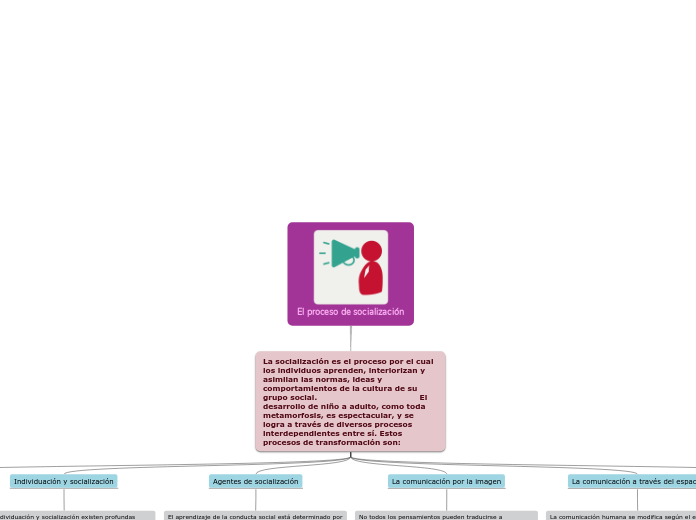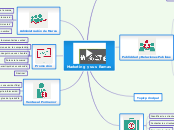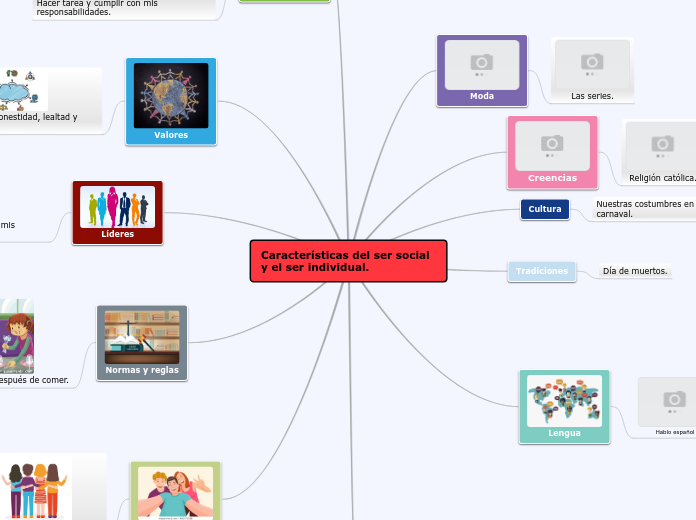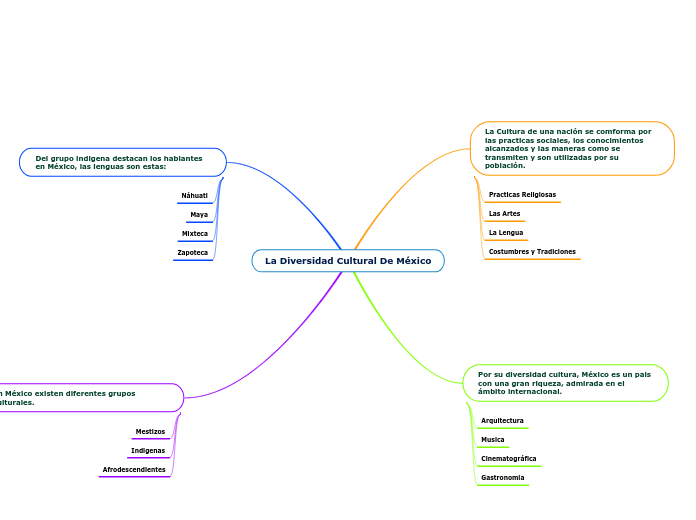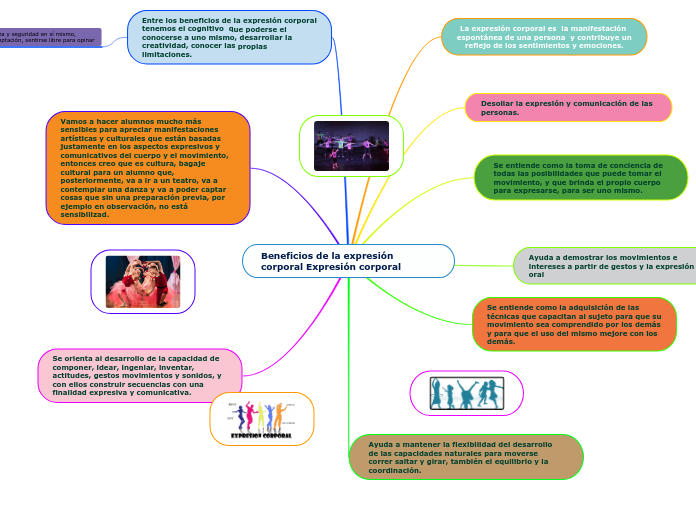El proceso de socialización
Type in the name of the multiple-perspectives text.
Example: Bridge to Terabithia by Katherine Paterson
La socialización es el proceso por el cual los individuos aprenden, interiorizan y asimilan las normas, ideas y
comportamientos de la cultura de su grupo social. El desarrollo de niño a adulto, como toda metamorfosis, es espectacular, y se logra a través de diversos procesos
interdependientes entre sí. Estos procesos de transformación son:
Identify an important issue from the text that is being presented from different angles. Type it in.
Example: Jesse's drawing talent.
La publicidad
Decide on the fourth point of view
Type in the name of the last character whose perspective on the issue you are going to present.
Example: Leslie Burke, Jesse's new next-door neighbor, and best friend.
Las funciones de la publicidad son las siguientes:
• Crear y reforzar un ambiente consumista. La publicidad pretende convencer, más que informar, crear demanda y
estimular el consumo.
• Unirse a la moda, que se encarga de acelerar la renovación continua de los productos de consumo y de la cultura
ligada a ellos.
• Difunde una ética materialista y hedonista a la vez que oculta los conflictos y problemas sociales. En esta sociedad
consumista, el dinero se convierte en la vara de medir el valor de las personas. Se asume que el trabajo mejor
remunerado es el más importante socialmente.
• Asignar valores simbólicos. La publicidad configura modelos simbólicos y el consumidor aprende qué productos
simbolizan juventud, prestigio, salud, belleza, en cada momento.
• Burlar la vía consciente. Hay dos formas de procesar una información: por la vía central o por la periférica, de
forma crítica o acrítica.
• Producir un ser humano banal. El sistema formado por la publicidad-modaconsumo conforma un modelo cultural
(nueva forma de socialización), que contribuye a un cambio antropológico, a un nuevo tipo humano adaptado a las
necesidades del sistema económico, basado en el incremento del consumo inconsciente.
Point of view
Type in a relevant quote that highlights the character's point of view. Try to follow a citation format: author's name, chapter, and page.
Example: I can't get the poetry of the trees,' he said. She nodded. Don't worry,' she said. You will someday. He believed her.' (Paterson, 4. 24)
La comunicación a través del espacio
Whose character does the third point of view belong to?
Type in his/her name.
Example: Mr. Aarons, Jesse's father.
La comunicación humana se modifica según el espacio en que se realiza: si un profesor quiere tener relaciones
igualitarias con sus alumnos se cita con ellos en la cafetería y no en el despacho. Asimismo, los conflictos entre jefes
de Estado suelen resolverse en países neutrales.
What does the character think, say or do that suggests their perspective on the issue?
Type in a quote and try to maintain the citation format.
Example: 'He would like to show his drawings to his dad, but he didn't dare. (...) He'd thought his dad would be pleased. He wasn't. What are they teaching in that damn school? he had asked.' (Paterson, 2.8)
Distancia íntima (hasta 45 cm). Reservada para las personas con relaciones afectivas intensas, como las que
mantiene una pareja de novios.
• Distancia personal (45 cm a 125 cm). Relaciones en actividades habituales como el trabajo o las conversaciones
que mantenemos en la calle.
• Distancia social (1.25 m a 3.60 m). Relaciones con personas que desconocemos o con las que no tenemos trato
personal, por ejemplo, las relaciones profesionales de oficina.
• Distancia pública (3.60 m a 7.50 m). Relaciones con un grupo. El comunicador juega un papel social, marca las
distancias. En el mitin de un político, el discurso está formalizado, los gestos son estereotipados, la comunicación se
convierte en espectáculo y los espectadores son pasivos.
What kind of narration introduces the viewpoint?
Choose an answer:
First person point of view - using the personal pronouns 'I' or 'we'Second person point of view - using the personal pronoun 'you'Third person point of view - using the third-person pronouns 'he', 'she' and 'they'Omniscient point of view - an all-seeing observer tells the story
La comunicación por la imagen
No todos los pensamientos pueden traducirse a imágenes, pero la imagen tiene una capacidad emotiva de la
que carece la palabra. La comunicación mediante imágenes es hoy omnipresente y alcanza a muchos destinatarios,
pero se ejerce en sentido único: los papeles de emisor y destinatario no pueden intercambiarse.
Agentes de socialización
Decide on the second point of view
Name the character (it can either be the main character or one of the supporting characters) whose point of view you are presenting.
Example: Miss Edmunds, Jesse's music teacher.
El aprendizaje de la conducta social está determinado por varios agentes de socialización (familia, compañeros,
maestros, televisión, etc.), que sirven de modelos sociales o agentes reforzadores y favorecen la socialización. los mas importantes son:
Type in a quote that points out the character's position about the issue.
Try to follow a citation format: author's name, chapter, and page.
Example: 'She said he was unusually talented, and she hoped he wouldn't let anything discourage him.' (Paterson, 2. 8)
• La familia. Es el primer y más importante agente de socialización, ya que aporta la experiencia social más temprana
y constituye la red social más duradera.
• La escuela. La institución educativa es el lugar donde se aprenden normas, valores y pautas de comportamiento
social. Aquí se produce el salto de un sistema basado en las relaciones de afecto familiares a otro basado en la
transmisión de contenidos y valores culturales.
• El grupo de compañeros o “pares”. La influencia de los compañeros es decisiva para el aprendizaje de valores y
actitudes, habilidades sociales, hábitos de comportamiento, roles sexuales.
How is the viewpoint introduced in the story?
Choose an answer:
First person point of viewSecond person point of viewThird person point of viewOmniscient point of view
Individuación y socialización
Decide on the first point of view you are going to present.
Type in the name of the character (it can either be the main character or one of the supporting characters) whose point of view belongs to.
Example: Jesse Oliver Aarons, Jr., the main character of the novel, a fifth-grader living in a rural Southern area.
Entre individuación y socialización existen profundas conexiones, las dos actúan de forma paralela en el desarrollo
y son las dos caras opuestas de una misma moneda, ya que cuanto más sabe uno acerca de sí mismo, más sabe acerca
de otros, y viceversa. Estar socializado significa poder vivir en un mundo socialmente organizado y
aprender una serie de competencias sociales:
Type in a relevant quote that highlights the character's point of view towards
La socialización es el proceso por el cual los individuos aprenden, interiorizan y asimilan las normas, ideas y
comportamientos de la cultura de su grupo social. El desarrollo de niño a adulto, como toda metamorfosis, es espectacular, y se logra a través de diversos procesos
interdependientes entre sí. Estos procesos de transformación son:.
Try following a citation format: author's name, chapter, and page.
Example: 'Jesse drew the way some people drank whiskey. (...) Lord, he loved to draw. (...) When he was in first grade, he told his father that he wanted to be an artist when he grew up.' (Paterson, 2. 7)
• Pensamiento de medios-fines y de soluciones alternativas.
• Capacidad de juzgar las consecuencias de las acciones sociales.
• Flexibilidad para adoptar perspectivas sociales diferentes de las propias.
• Sensibilidad social (empatía).
What type of narration introduces the viewpoint?
Choose an answer:
First person point of view - using the personal pronouns 'I' or 'we'Second person point of view - using the personal pronoun 'you'Third person point of view - using the third-person pronouns 'he', 'she' and 'they'Omniscient point of view - an all-seeing observer tells the story
comunicación de masas
La
comunicación de masas es el conjunto de procedimientos que los grupos de especialistas utilizan para vulgarizar un
contenido informativo o simbólico. Habitualmente, los diferentes medios de comunicación (prensa, radio, cine, televisión o Internet) son
acusados de saturar a la gente con su avalancha de datos y comentarios, de asumir la función de distracción y evasión más que de información.
